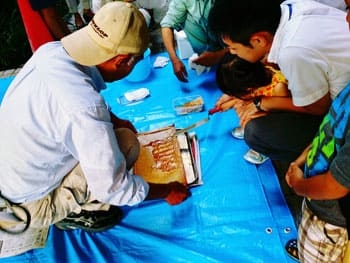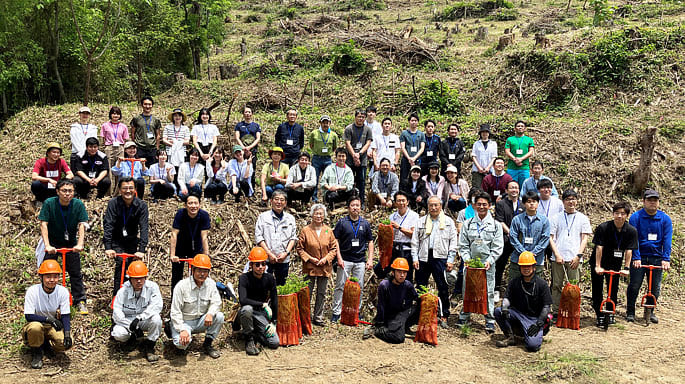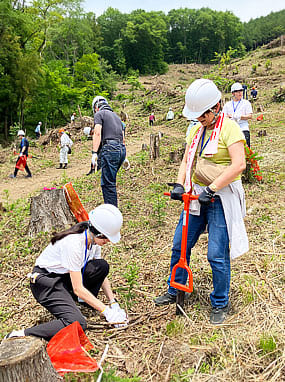Policy
Basic Views
The IINO Group's environmental policy states that "we will avoid having an impact on biodiversity and seek restoration should any impact occur. In addition, we will curb greenhouse gas emissions, respond to the impact on climate change by reducing emissions, and pursue investments in tangible and intangible assets that help reduce the impact on the environment in order to cut air pollutant emissions." In keeping with this approach, we strive to preserve biodiversity in all aspects of the Shipping Business and Real Estate Business. We recognize that the preservation of biodiversity is a social issue that we must actively tackle as a member of society, and it is regarded as an element of the IINO Group's materiality (key sustainability issues). As part of those efforts, we are introducing ballast water treatment equipment on our vessels and also working on forest development.
Initiatives
Initiatives to Preserving Biodiversity
Stern Tube Air Seal Equipment and Use of Environmentally-Conscious Lubricating Oil
Leaks of oil or chemical substances can lead to serious consequences such as marine pollution and adverse effects on people and other living organisms. To prevent marine pollution accidents on our vessels, we thoroughly enforce safety measures, including crew training and the appropriate operation and maintenance of related equipment. In addition, stern tube air seal equipment, in which pressurized air shuts off lubricating oil and seawater, is employed on vessels to prevent lubricating oil from leaking from the shaft seal device of the propeller shaft, which penetrates from the hull into the sea.
Furthermore, in anticipation of lubrication oil leaks, we are adopting environmentally-conscious lubricating oil that quickly dissolves naturally in the ocean to provide double leakage prevention.
Forest Maintenance Project in Nagatoro Town, Chichibu District, Saitama Prefecture
On February 2, 2023, we concluded the "Saitama Prefecture Forestation Agreement" with the Chichibu Regional Forest Association (President: Hirofumi Yoshida) and Saitama Prefecture (Governor: Motohiro Ohno), and are investing in the creation of a 7-hectare forest in Nagatoro-cho, Saitama Prefecture.
As part of the reforestation project, Group executives and employees volunteered to plant trees in May and planted "low-pollen Japanese cedar," which contains 99% less pollen than conventional species.
Through this initiative, we will support the domestic forestry industry, utilize timber originating from the target area, improve water conservation and flood control mainly in the Arakawa River basin, and improve management of water supply sources, as well as contribute to the maintenance of rich forests that lead to the abundant sea (Tokyo Bay).
Environmental Preservation Activities in the IINO Forest
The IINO Forest, a public space at the IINO Building created in 2014, was designed with the intent of connecting the greenery of the Imperial Palace and Hibiya Park.
Based on the concept of restoring potential natural vegetation, we engage in environmental conservation activities that take biodiversity into account at the IINO Forest. The IINO Forest is made up of around 80 plant species, mainly medium and tall trees. When selecting which species to plant, we enlisted the help of TAKENAKA CORPORATION to conduct a geographical survey based on documents from the Edo period and a survey of current vegetation in the surrounding area. We also consulted potential natural vegetation maps. In addition, we identified ten species of bird and 11 species of butterfly based on past living organism habitat survey materials and designated them as target species to be attracted to the IINO Forest. For long-term vegetation management purposes, once every five years, we conduct a survey of living organisms to verify the situation and reflect the findings in later vegetation management activities. In addition, based on a solid management system that includes around 156 patrols each year and quarterly examinations by an arborist, we are doing our utmost to manage and maintain the inner-city environment and consider biodiversity.
In March 2018, the IINO Forest was certified as an EDO-MIDORI Tokyo Green Site (Excellent Greenery Site) by the Tokyo Metropolitan Government Bureau of Environment.
Honeybee Project at the IINO Building
The IINO Building has been beekeeping Japanese honeybees since 2014 by setting up Japanese honeybee hives. Unlike Western honey bees commonly kept in Japan, Japanese honey bees have a habit of abandoning their hives in response to environmental changes or a decrease in food resources. In Tokyo, there are many cases of Western honeybees being kept on the rooftops of buildings, but there are not many cases of Japanese honeybees being kept continuously. The continuity of Japanese honey beekeeping is a symbol of our ability to implement low-pesticide management with a low environmental impact. It also shows that we provide a suitable environment for bees and a green space that is considerate of the ecosystem.

Recognition
External Recognition

Certification from the Association for Business Innovation in harmony with Nature and Community (ABINC)
First Special Award
IINO Building
Office building that undertakes measures to preserve biodiversity, including protection of local animal populations and raising Japanese honey bees

EDO-MIDORI Tokyo Green Certification
(Excellent Greenery Site)
IINO Building
Greenery facilities considerate of local vegetation and organisms, working for environmental recovery appropriate for Tokyo wildlife

